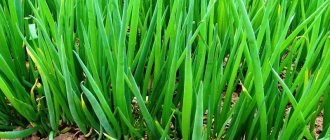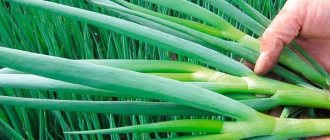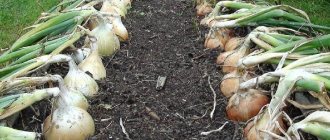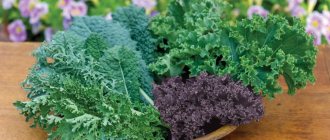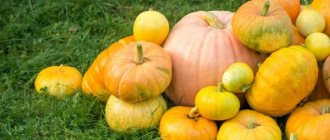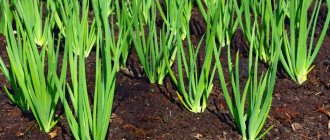Description of the crop and choice of variety for open ground
Onion is a perennial plant from the Onion family. The birthplace of culture is the territory of Asia. It grows wild in Mongolia and China. In Russia, batun is cultivated almost everywhere, with the exception of the Far North. Caring for it is not particularly difficult.
The above-ground part is similar to onions - the stems are long, tubular, but denser. The underground part is represented by a false, short, bleached stem and lacks a rounded turnip.
Onions are grown for their greenery. The plant spends all its energy on the formation of tubular leaves. If they are not cut in time, they can reach 60-70 cm in height and 20-25 mm in diameter. The maximum wall thickness is 1.5 mm. Such a feather is considered overgrown and unsuitable for consumption due to excessive hardness and lack of taste.
The false bulb, or stem, is also eaten. The bulk of the roots are located at a depth of 30 cm.
In Russia, due to climatic conditions, early or mid-early varieties of onion are grown:
- Aprilsky is an early ripening variety. The harvest is harvested in April. It is resistant to most onion diseases. The taste is pleasant, sweet and spicy.
- Russian winter is a mid-early variety, resistant to frost. The leaves are bright green in color, up to 35 cm high. The taste is delicate and sweet.
- Baia Verde is a mid-early variety. The leaves are green in color, up to 40 cm high. The taste is pungent. The aroma is pronounced onion.
- Giant is a mid-early variety with high resistance to frost. The leaves are thick, fleshy, up to 50 cm high. The taste is spicy-sweet.
- Seryozha is an early variety with high resistance to frost. The leaves are bluish-green, up to 55 cm high, with a pleasant, sweet taste without pungency.
- Gulden is a mid-early variety. The leaves are juicy, tender, low-growing, up to 40 cm in length. The taste is medium hot.
- Damast is an early ripening variety. The feathers are green, erect, covered with a waxy coating. Stem height - 30 cm, diameter - 11 mm. The taste is pleasant, sweet.
- Zelenets is an ultra-early variety. Feathers up to 80 cm in length, bright green. The taste is sweetish, semi-sharp.
- Kaigaro is a mid-season variety. The leaves are erect, bluish-green, up to 50 cm in height. The taste is delicate, sweetish, semi-sharp.
- Red is an ultra-early variety with the possibility of harvesting a month after planting. The feathers are tall, up to 70 cm in length, green in color. The taste is pleasant, medium-sharp, sweetish.
- Emerald is an early variety. The feathers are dark green in color, with a waxy coating, 70-85 cm long. The taste is delicate and sweet.
- Tenderness is an ultra-early variety, ripens 30 days after sowing. The feathers are green, with a slight waxy coating, up to 35 cm high. The taste is sweet, semi-sharp.
The photo shows a spring onion.
Features of the plant
Onion is a perennial herbaceous plant belonging to the Onion family. It is also called Tatarka, onion, etc. As a wild plant, it is widely represented in Siberia, the islands of Japan and China.
The green onions are juicier and more tender in comparison with onions, which is why they are widely cultivated in our country; they are not planted except in the Far North. The spring onion does not form the usual onion; it is replaced by a slight thickening - a false onion.
Interest in this perennial plant - a source of onion greens - is associated with its high yield, unpretentiousness and resistance to low temperatures.
Growing spring onions does not require much hassle.
You can grow a plant in one place for no more than 5 years. During this time, the onion bushes will grow - each onion plant will form 4-5 daughter plants in just 1 year, forming up to 30 branches per bush.
If the seeding is excessively thickened, the following problems naturally arise:
- feathers become small;
- the quality of the crop deteriorates.
To eliminate them, the following methods are used:
- overgrown bushes of the plant are divided into several parts and planted in beds, increasing the yield of onion greens;
- overgrown bushes are dug out along with a lump of soil and planted in greenhouses or greenhouses for forcing in the winter.
Basic rules for growing onions in open ground
The crop is not particularly demanding in terms of cultivation and care, however, to obtain a harvest, a number of rules are followed:
- planting after legumes (undesirable after tomatoes due to the risk of infection with fungal diseases);
- soil pH norm - 6.5-7.5 units;
- seed sowing density in open ground - 2 g per 1 m²;
- sowing width - 18-20 cm, depth - 1-2 cm;
- mulching the soil with humus after sowing, followed by compaction of the top layer;
- soil moisture control;
- removal of weeds;
- double thinning of plantings when sowing batun as a perennial;
- application of complex fertilizers.
How to grow onion seedlings
To obtain an early harvest of onion, it is planted through seedlings. Seedlings are planted in early January in a greenhouse and harvesting can begin in July. By resorting to such agricultural technology, the trumpet plant is not considered a perennial plant and the crop is harvested completely with the bulb. Just as they do when growing green onions from seeds. Before sowing seeds for seedlings, you need to prepare the substrate. In principle, its composition is no different from that required for growing seedlings of other crops. To do this, you need to use: 50% ordinary soil, 30% humus or compost, 10% rotted sawdust or hydroperlite, 10% sand. There is no point in adding any chemical fertilizers. Firstly, all the essential nutrients are found in humus or compost. Secondly, when growing seedlings, onions use seed reserves and practically do not use fertilizing from the substrate.
After the substrate is prepared, you need to sow the seeds of the batun. Pre-prepare the seeds using one of the methods described above. The container in which the onion seedlings will be grown must have holes at the bottom to quickly remove excess water after watering. I recommend growing seedlings not in cups and pots, but in long tubs. Pre-prepared soil is poured into the container and watered. After a couple of hours, when the soil has gained moisture and excess water has drained, make grooves with a pencil. The depth of the grooves should be no more than three centimeters. Onion seeds are sown in furrows and sprinkled with humus or sawdust. After the seeds are sown and covered, the grooves are lightly compacted. This is done for better contact of seeds with moist soil.
Landing dates
Experienced gardeners advise focusing on the climatic characteristics of the growing region. The optimal sowing time is the beginning of March (harvest in June) or the first days of July (harvest in October).
When sowing in winter, the seed material is embedded in cold, but not frozen soil. In the central regions this happens at the end of October. If sown early, the seeds will begin to germinate before winter and will die from severe frosts.
Sowing dates and preparing seeds for planting
When growing a crop without seedlings, it is planted in beds prepared in advance in June-July. Due to the sufficient length of daylight, the seedlings grow strong during this period. By winter, the plant manages to accumulate enough nutrients to survive until spring.
Pre-winter sowing of onions is carried out in October-November to obtain early greenery. After sowing, the area is mulched with peat.
The crop is planted for seedlings in mid-April. It is planted in a permanent place after June 10. In the fall, if the trumpet is grown as an annual, its greens are removed along with the false bulbs.
Preparation for cultivation
Planting onions begins with preparatory work: dressing the seeds, plowing and fertilizing the area.
Planting material
It is not recommended to pour seeds into furrows directly from the bag. This reduces the germination percentage and increases germination time.
To make batun seeds germinate faster, they are soaked in a weak solution of potassium permanganate for 20 minutes, then placed in clean water for 24 hours. Change the water 2-3 times. To stimulate germination, the material is treated with succinic acid, Epin or Zircon. After soaking, the seeds are not washed and dried until they flow.
For sowing, take seeds collected from your own plot or purchased from gardening stores.
Priming
The area for sowing onions is prepared in advance - in autumn or spring. The ground is plowed to a depth of ½ bayonet shovel. Deep digging does not make sense due to the compact root system.
During the digging process, the soil is carefully inspected and weeds along with roots are selected. This is important because the shoots of the batun are as delicate as strings, and when you pull the weed out of the ground, it is easy to pull the onion along with it.
For productive cultivation of crops, the nutritional value of the soil is increased by applying fertilizers. Clay soil is loosened with the addition of sand (10 liters per 3 m²) or wood ash (200 g per 1 m²). Acidic soil is deoxidized with dolomite flour - 400 g per 1 m².
When preparing the site in the fall, rotted manure is scattered over the dug up bed. 15 days before planting, add 25-30 g of nitroammophoska per 1 m².
Preparing a site for planting onions
Some gardeners are wrong to consider this culture capricious. Batun gives good results, provided that the preparation of the area for planting batun onions is done correctly. For fruitful cultivation, fertile soil containing balanced nutrients is necessary. It is also worth noting that this plant reacts poorly to acidic soils. Before planting onion, you need to add lime or dolomite flour to the soil. Nitrogen, magnesium, phosphorus and potassium are added to the soil as nutrients. After all components are added to the soil, the soil is dug up or milled.
In the process of preparing the soil for onion, which is planned to be grown for several years in a row, special attention is paid to soil aeration. The soil in open ground should be well structured and crumbly. This quality of the substrate prevents the soil from becoming waterlogged during the process of watering the batun - which he loves so much. A crumbly soil structure can be achieved by adding horse manure or rotted softwood sawdust. Remember one rule - “the onion loves the chopper.” In the process of growing onions, the beds must constantly be loosened. Loosening the soil is done every two to three waterings.
Despite the fact that the soil has been properly prepared, during the growing season the onion takes nutrients from the soil and must be fed with nitrogen and potassium fertilizers. In winter, onions must be sent fertilized. To do this, manure and phosphorus fertilizers are applied between the rows, after which everything is dug up. Either manure or phosphorus fertilizers will release nutrients into the soil over the winter and in the spring the onion will receive high-quality nutrition.
Photo: Onion from seeds
Landing rules
Seeds are sown in rows. Furrows of up to 2 cm are formed in the soil with an interval of 25-35 cm. The material is sealed at a distance of 15 cm. Dense sowing with an interval of 5 cm during annual cultivation of batun allows you to obtain aligned shoots and increase productivity. However, weeding and loosening such plantings is difficult.
Dry grains without pre-treatment are sown in dry soil, pickled and soaked in growth stimulants and embedded in moist soil. The furrows are watered abundantly with clean water and sowing is carried out when the water is completely absorbed.
A layer of soil is poured on top and watered again. Then they are mulched with hay, straw or peat or covered with agrofibre.
Advice. To facilitate the process of thinning plantings, mix nigella onions with radish seeds, which germinate much earlier. As you harvest your radishes, you will automatically thin your onions.
Planting onion seeds
It is worth noting that planting batun onion seeds is universal in terms of sowing time. The only exception is winter. And so, batun seeds can be sown at any time of the year and in any month. Of course, if you are sure that you can, for example in July, during intense heat, provide the planting with constant watering. If not, then the seeds simply will not hatch and will steam under the crust of the soil. The optimal and simpler time for planting onion seeds is traditionally spring or autumn. In both the first and second options, the soil is saturated with moisture and the seeds germinate well and quickly.
Planting of onion seeds is carried out in shallow grooves, like any onion seeds that are grown for feathers. Typically, the depth of the furrow is 1.5-3 cm. Before planting batun seeds, if you do not use precision seeders and plan to sow manually, I recommend mixing the seeds with sand 1:1. This will allow the seeds to be sown more evenly and less densely. Upon completion of sowing, I advise you to sprinkle the seeds with peat, humus or sawdust. Then water generously. After thorough watering, the upper substrate will be saturated with moisture, the onion seeds will quickly hatch and sprout.
The width of the beds should not be ignored. It should be at least 35 cm, which will allow you to easily care for the trampoline and there will be sufficient row spacing that can be dug up in the winter. Next, when the seeds have sprouted and the formation of the first true leaves has begun, the beds are thinned. A distance of 3-5 cm is left between each plant. While the onion is gaining strength, it requires care in the form of constant watering. If the seeds were planted towards the end of spring, watering is done in the morning and evening daily. But! — waterlogging of the soil is not allowed.
Features of growing by seedling method
Growing batun through seedlings allows you to avoid the troublesome weeding and get a harvest in 2-2.5 months from the moment of the first shoots.
To obtain seedlings, the seeds are first disinfected in potassium permanganate and soaked in water for 24 hours. Then they are sown in individual cups filled with a moist substrate of equal parts of turf and humus to a depth of 2 cm with an interval of 5 cm. Sprinkle with soil on top, cover with film and wait for germination.
Then the seedlings are taken out to a sunny windowsill and the film covering is removed. The optimum air temperature is +16°C during the day and +10…+12°C at night.
Caring for seedlings includes timely watering and fertilizing (once every 14 days). To do this, use superphosphate or nitrophoska (2 g per 10 liters of water).
When the weather becomes warm outside, the threat of night frosts disappears and the soil warms up to +12°C, the seedlings are transferred to open ground. Beds 1.5 cm deep are formed on the site. Seedlings are planted together with a ball of earth at intervals of 3 cm and covered with agrofibre for 3-4 days.
Features of care
After proper planting of the onion, in order to obtain a bountiful harvest of greenery, caring for it must be correct and regular. The plant is moisture-loving and needs to be moistened quite often. The soil should be wet to a depth of about 20 cm. If the summer is not dry, then 1 watering per week is enough. In hot and dry weather, plants are watered every other day. Pour water at the root.
You should weed the onion bed regularly to prevent weeds from growing. Loosening row spacing is necessary for proper root respiration of plants. It should be carried out not deeply, so as not to injure the roots, and about once a week.
Nutrients for onions are applied in the form of fertilizing. The first time it is carried out with saltpeter as soon as shoots appear (8 g per 1 m2). The second feeding is carried out with potassium chloride at the end of summer (6 g per 1 m2). In addition, at the beginning of spring, while the soil has not yet thawed, nitrogen fertilizers (10 g per 1 m2) and potassium (6 g per 1 m2) are applied.
After the growing season ends, the leaves are cut off, as in the future they will interfere with the growth of new ones or may cause plant disease.
In order for the perennial onion to overwinter safely, the feathers are not cut off for the winter in the year of sowing.
Further care
Rules for caring for onion plantings:
- The frequency of watering directly depends on the amount of precipitation in the growing region. During drought, the plant is watered 2-3 times a week. To obtain a large amount of greenery, watering is increased up to 4-5 times every 7 days. It is important not to let the soil dry out.
- Loosening the beds is carried out after each watering to prevent the formation of an earthen crust and improve the aeration of the underground part.
- Weeds are removed as they grow, without waiting for rooting. This is especially important at the very beginning of onion growth, when the feathers are thin and weak.
- Thinning of seedlings is carried out twice: the first time after the sprouts appear, leaving a gap of 2-3 cm, and the procedure is repeated after the plant gets stronger, achieving a gap of 5-7 cm.
- When planting early at the end of June, the lower green feathers are trimmed, leaving the young top to form lush greenery.
- Onions are fed twice per season: when planting - a solution of chicken manure diluted in a ratio of 1:15, after emergence - 10 kg of compost, 150 g of ammophosphate per 1 m². It is enough to add 200 g of wood ash per 1 m² to fertile soil.
In the fall, the spring onion does not need care - the plant goes into the sleep phase and withstands the cold until spring.
Diseases and pests
If the rules of agricultural technology are followed, the batun rarely gets sick and is not attacked by insects. If growing conditions are unfavorable, the plant is infected by fungi that cause peronosporosis (downy mildew) - the leaf plastic is covered with a gray-violet moldy coating. To prevent and treat the disease, copper-containing preparations are used: “HOM”, “Oxychom”, copper sulfate. Usually 2-3 treatments are enough.
Onion weevils, onion moths and onion flies often attack spring onions. The moth gnaws the leaves from the inside, leaving only a thin peel. Adult onion weevils pierce the feathers and suck out the juice. Weevil larvae burrow into greenery and feed on plant tissue. Onion fly larvae eat the bulbs, causing the plant to wilt and turn yellow.
For pest control use:
- insecticide “Fufanon”, safe for humans;
- mustard powder solution (1 tbsp per 10 liters of water);
- infusion of potato tops (1 kg of greens per 10 liters of water, consumption per 1 m²).
Prevention of diseases and the spread of pests:
- crop rotation;
- thinning of plantings;
- planting carrots next to onions;
- control of soil moisture levels;
- weed removal;
- Frequent inspection of plants.
Planting seeds in the ground
To sow seeds on a site, you will need to prepare beds and seed material.
Recent Entries
Lilac perennials that are beautiful, compact and do not crowd out other plants Why when buying seedlings you should not take the sellers’ word for it and how to determine the age of the plant using 3 signs Tomato seedlings have turned purple or whitish: why the color has changed and how to save the plants
Soil preparation
Onion prefers fertile soils with a slightly acidic or neutral reaction. It is advisable to choose light loam or sandy loam soils. Heavy clay and acidic areas, as well as those located in lowlands and flooded with water, are not suitable for cultivation. Onions can be grown on sandy soils, but this produces a large number of flower stalks, which negatively affects the yield.
It is preferable to plant the crop after potatoes, cabbage, zucchini, pumpkin, and also after green manure. The main thing is that organic fertilizers are not applied to the predecessors, which can cause weeds to grow. You should not plant spring onions after garlic, cucumbers, carrots, or after onions, as this will contribute to the development of pathogenic microorganisms in the soil. Since the type of onion in question is a perennial plant and can grow in one place for 4 years, the bed for planting it should be thoroughly prepared.
The soil for planting onions is fertilized with organic and mineral substances
In areas with acidic soil, add wood ash at a rate of 0.5 kg per 1 m² six months before sowing. Poor soils are fertilized 2 weeks before planting with the following components:
- humus - 3–5 kg;
- superphosphate - 30–40 g;
- ammonium nitrate - 25–30 g;
- potassium chloride - 15–20 g.
As for seed preparation, it is carried out in the same way as when sowing seedlings. It is important to consider that soaked seeds should be planted only in moist soil, otherwise they will simply die in dry soil.
Sowing time
Sowing the crop in unprotected soil begins in early spring and ends in early summer.
Planting and caring for onions, regardless of the time of the procedure, has virtually no differences.
Since the type of onion in question is suitable for cultivation in the Russian climate, the air temperature during the period of forcing arrows can be in the range of +10–13˚С. Greens can withstand temperature drops down to -4–7˚C. This suggests that sowing seeds can be done as soon as the soil warms up slightly.
Sowing onions in open ground can be done from early spring until mid-August or before winter
If the crop is grown as an annual plant, then the seeds can be sown as soon as severe frosts have passed. In most cases, the timing is March-early April. If onions are cultivated as a perennial, then the seeds are planted in early summer or autumn. It is worth taking into account that when planting in the fall, the greenery begins to develop in the spring, as soon as the snow melts and the soil thaws.
Sowing
Spring onions are sown in the garden bed in pre-made furrows. You can adhere to the following crop planting scheme:
- the distance between seeds in a row is 10 cm;
- between rows 20 cm;
- embedment depth 3 cm.
Seeds are sown in the garden bed to a depth of 3 cm, between seeds 10 cm and between rows 20 cm
The seed can be immediately spread at the desired interval. If the planting is denser, thinning will be required. It is carried out when the first true leaf appears. If the crop is planted in the fall, thinning is performed the following year, when seedlings appear.
Video: sowing onions in open ground
Onion care
The main agrotechnical techniques for caring for spring onions are watering, fertilizing, and loosening. Watering the crop should be moderate, and the frequency and volume should be selected according to your region, i.e., based on the climate. So, in some regions it will be enough to moisten the soil once a week at the rate of 10 liters per 1 m² of beds, while in others more frequent watering may be required - 3-4 times a week.
The first weeding is carried out in order to thin out dense plantings, leaving 6–9 cm between plants. After this, the soil between the rows is loosened, which helps to improve the harvest. In the future, the loosening procedure is carried out after watering and rain.
You need to fluff the soil carefully to avoid damaging the roots of the young onions.
One of the important procedures in caring for onions is loosening, which ensures better plant growth
An important condition for obtaining a good harvest is the introduction of nutrients. Onions are fed several times during the season. The first feeding is carried out in early spring using organic matter (mullein 1:8 or infusion of bird droppings 1:20). Mineral fertilizers are applied in the spring a month after germination and in the fall 30 days before frost. Potassium nitrate is used as fertilizer, consuming 14 g per 1 m². In the summer, for additional feeding of onions, the beds can be lightly sprinkled with wood ash.
Harvest and storage
The first harvest is cut 30 days after entry. 45 days after planting, the final harvest of succulent greenery is carried out.
Green feathers are torn off by hand or cut with a sharp knife at a distance of 5 cm from the ground. The onion is not pulled out. The greens are placed in boxes or wrapped in plastic and stored in a cool place.
Onions can be frozen and stored in the freezer for up to a year. Greens can stay in the vegetable compartment of the refrigerator for up to 30 days.
Juicy feathers are suitable for drying in the oven, electric dryer and outdoors. Dry raw materials are stored in paper bags or glass containers for up to a year.
Harvesting
The crop is grown only for the sake of obtaining greenery. It’s time to cut it when the height of the leaves reaches 15-25 cm. Then the onion harvest is cooled and stored in the refrigerator, put in a bag without bending the feathers. During the season, greens are harvested from 2 to 4 times, depending on the variety. Each time after cutting, nitrogen-potassium fertilizers are applied to the crop and watered, then the onion quickly grows back.
Cutting is stopped 6 weeks before frost. This is necessary so that the onions are prepared for winter and accumulate a sufficient amount of nutrients. If the crop is grown as an annual, then in the fall it is dug up with a false bulb. Such onions should be stored in the same way as cut ones.
Growing onion greens in greenhouse conditions
Planting material for forcing green onions in greenhouse conditions must be prepared in the fall. 3-year-old onion bushes dug up along with the ground are well suited for this. They should be planted in a greenhouse, having first necessarily cut off the leaf part of the planting material by about 1/3.
Onion will give a good harvest even when grown in a greenhouse
In the spring, the planted bushes will begin to grow actively - the period of forcing green feathers for spring onions is 2 times shorter than for ordinary onions. And the onion greens of the usual turnip are inferior in taste - the feathers of the onion are tastier and more tender.
